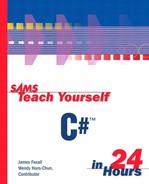Creating an Instance of an Automation Server
Referencing a type library allows C# to integrate the available objects of the type library with its own internal objects. After this is done, you can create object variables based on object types found in the type library. Excel has an object called Application, which acts as the primary object in the Excel object model. In fact, most Office programs have an Application object. How do you know what objects an automation server supports? The only sure way is to consult the documentation of the program in question or use the Object Browser discussed in Hour 3, “Understanding Objects and Collections.”
 | In this example, you'll be using about a half-dozen members of an Excel object. This doesn't even begin to scratch the surface of Excel's object model, and it isn't intended to. What you should learn from this example is the mechanics of working with an automation server. If you choose to automate a program in your own projects, you'll want to consult the program's developer documentation to learn about its object model; you're sure to be surprised at the functionality available to you. |
Double-click the button to access its Click event, and then enter the following code, which creates a new Excel Application:
Excel.Application objExcel = new Excel.Application();
Notice that C# included Excel in its IntelliSense drop-down list of available objects. It was able to do this because you referenced Excel's type library. Excel is the reference to the server and Application is an object supported by the server. This statement creates a new Application object based on the Excel object model.
